Is Metal 2 a Software or Hardware
AppleInsider is supported by its audition and may earn commission as an Amazon Associate and chapter partner on qualifying purchases. These affiliate partnerships exercise not influence our editorial content.
The new Mac Pro is a long-anticipated development for Apple tree's high end pro users, but it certain looks equally if the company likewise created the machine for its own strategic do good — specifically to help make its Metal API become a dominant standard for GPU-intensive software. That could have big implications for Macs, iOS devices, and Apple GPUs going forrad, with history providing some insight into why this matters.
Over the last decade, GPU maker Nvidia has established its CUDA platform every bit the most popular way to build intensive compute workflows in parallel computing, 3D and CGI rendering, and in automobile learning— the company has claimed an 80% share of the inference processing market. CUDA is also widely adopted in video game software engines and professional film, music, and prototype editing software. This strategy has paid off, as using CUDA software requires an Nvidia GPU.
That raises the question of how Apple tin can expect to launch its new Mac Pro into the professional person space without any apparent support for Nvidia'due south latest GPUs. It'southward like Apple launching the original Macintosh without support for DOS software, or iPod without any style to playback Windows Media Thespian files, an iPhone without Java, or iPad without Adobe Flash. It's boldly insane to pundits, but it'due south also exactly the kind of high stakes adventure that has regularly worked out well for Apple tree and its customer base.
Conduct with me through a cursory history of how we got to the current situation in GPU-accelerated computing tasks, and have a wait at where the industry is headed as we brainstorm a new decade of technology in the 2020s.
The software of GPUs
Long ago, the get-go Macs of the 1980s handled graphics operations in software running on their CPU. While Apple has long been considered a hardware company, the Mac'southward truly differentiating features — its graphical user surroundings powered past QuickDraw and later its pioneering video capabilities from QuickTime — were the results of the company'due south sophisticated software.
That software was so skillful — and its function was so valuable and of import— that Microsoft and Intel worked to steal Apple'due south code representing proprietary video acceleration techniques to deliver a functional Video for Windows in the early 1990s. That launched a dispute that wasn't resolved until Microsoft agreed in public to invest in Apple and go on writing Function for the Mac in 1997.
Despite that deal, and Apple's offset-mover position in bringing Xerox PARC's enquiry-form graphical computing to mainstream audiences, Apple overwhelmingly lost its fight to stop Microsoft from appropriating its work across the 1990s. Apple tree was also unable to successfully continue up in the development of loftier-cease, state-of-the-fine art graphics— in office because its executives pushed out Steve Jobs, who so took a whos-who of Apple'south talent with him in 1986 to target the high-stop of graphical calculating at Adjacent, Inc.
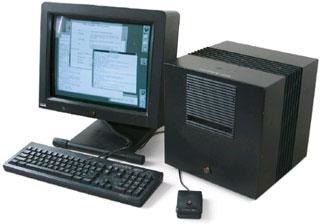
NeXT sucked away Apple engineering talent to pursue college-stop graphical computing
The graphical computing market itself was also changing rapidly, as graphics hardware accelerators quickly escalated in sophistication. Two companies founded in 1985— ATI and VideoLogic— began selling specialized video hardware, initially for other PC makers and later straight to consumers, to enhance graphics performance and capabilities.
By 1991 ATI was selling dedicated GPU cards that worked independently from the CPU. Past enhancing the gameplay of titles like 1993's "Doom," ATI's dedicated video hardware began driving a huge business that attracted new competition. In 1993, CPU designers from AMD and Sun founded Nvidia, and the following year former employees of SGI created 3dfx.
Apple was not only competing against Next and Microsoft as a graphical desktop calculating platform, just the Macintosh was also being outgunned in pro markets where various high-cease UNIX workstation vendors, including Silicon Graphics and Sunday, were quickly shifting to far more powerful new RISC CPUs while also developing their own specialized, high-end hardware to drive graphics supercomputers used to render CGI and perform simulations and research.
Graphics capabilities were exploding while component prices were speedily falling. In 1991, Apple tree replaced its ultrafast high-end, barely a twelvemonth old Mac IIfx— with a starting cost well above $17,000 in today's coin— with the much faster and more powerful Quadra 900, priced closer to a current-day $13,000. Apple was also publicly working to introduce PowerPC, a new RISC CPU that would be even faster. Imagine being a graphics pro at the fourth dimension, trying to survive while hardware values were collapsing into obsolescence so quickly.
On the loftier end, SGI was selling its $250,0000 Onyx workstations outfitted with the company's RealityEngine graphics compages, composed of a series of boards containing a dozen RISC CPUs and scores of huge custom ASICs. All this hardware was required to perform graphics operations that today announced comical (beneath).
The work to pattern and build integrated graphics hardware and software was incredibly expensive. It was also being performed in parallel past several companies competing over relatively minor pockets of demand. The industry was begging for some sort of collaboration.
SGI adjusted its RealityEngine graphics compages into a single fleck GPU and began licensing its internal Graphics Linguistic communication to others as OpenGL, a common platform intended to make it easier to write code that could run across the graphics hardware on different calculating systems. This helped create a competitive market for GPUs, specialized processors optimized to perform unproblematic, parallel tasks at high speeds that make them ideal for handling the repetitive pixel operations required in 2D and 3D graphics. SGI's OpenGL was given to an Compages Review Board in 1992, with members eventually including Apple tree, ATI, Dell, IBM, Intel, Microsoft, NVIDIA, SGI, Sun and 3dfx.
While OpenGL was aimed at high-end workstation graphics, Apple tree delivered its ain, simplified QuickDraw 3D API for 3D graphics on a Mac in 1995. Microsoft similarly acquired RenderMorphics in early 1995 and shipped information technology as Direct3D, aimed at making DOS PC gaming dependent upon Windows 95. Mac sales were low enough that QD3D inappreciably mattered, but Microsoft'due south Direct3D began challenging OpenGL's objective of having an open graphics library that worked across vendors.
Contention between OpenGL partners and Microsoft resulted in the 1997 Fahrenheit project to merge the two, to brand OpenGL piece of work on Windows NT workstations, similar to how IBM was working with Microsoft to merge its Bone/2 platform with Windows. But Microsoft backed out of both and focused on Direct3D and Windows NT in a bid to tie all graphics-intensive software exclusively to its Windows platform, leaving OpenGL and OS/2 for dead.
That occurred just every bit Apple was acquiring Side by side. When the returning Steve Jobs reviewed Apple tree'due south assets and prospects in 1998, he determined that Apple should drop QD3D and adopt OpenGL, creating pregnant new support for the open API and allowing Apple to focus its efforts on other technologies while benefitting from the existing work invested in OpenGL and its broad back up across existing GPU architectures. Rather than reinventing OpenGL, Apple adult a sophisticated new display server and graphics compositor for its adjacent-generation Macs.
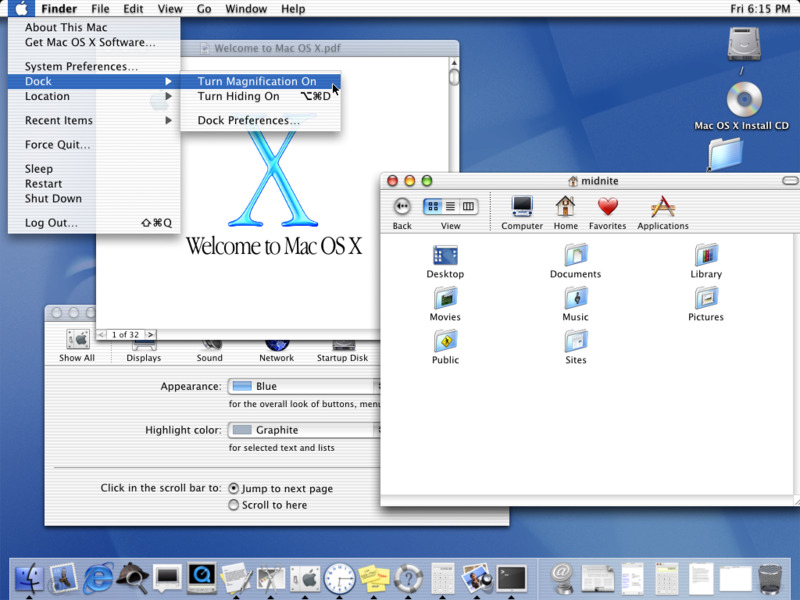
Mac Os X debuted with an avant-garde graphics compositor
Mac OS 10 shipped in 2001 with that new Quartz Compositor software cartoon its windows using techniques pioneered in video games, resulting in a fluid new Aqua advent (above) with slick animations, live video transforms, shadows, and blastoff translucency that made it clearly distinct from the flat, elementary bitmapped graphics however used past Windows XP.
In 2005, as Microsoft struggled to catch upward with own compositing engine in Vista, Apple tree released Quartz second Extreme, which took another folio from video games to hardware accelerate its graphics using OpenGL commands that could run direct on a GPU.
When Apple released the iPhone in 2007, its buttery smooth animation was the straight result of Apple'southward all-encompassing work in leveraging a GPU to deliver a satisfying graphical experience with responsive multitouch input. Years later, Google was still struggling to make its jerky, stuttering Android every bit smoothly, graphically responsive as iOS, complicated in role considering its cheapskate partners didn't want to spend much coin on GPU hardware, a gene Apple had made a priority.
Understanding and appreciating graphics was cardinal to Apple tree successfully launching the Mac in the 1980s, fueled Apple tree's ascent from the ashes in the 2000s in a world utterly dominated by Microsoft, so set the phase for the most successful consumer electronics production launch to always occur, and then helped to prevent Google and the residuum of the consumer electronics manufacture from collectively taking away Apple'south iOS crown and the trillion-dollar business it conferred. Graphics are a really big deal.
Making the GPU practice more than graphics
Adopting OpenGL twenty years agone enabled Apple to develop higher-level graphics software that could run on whatever major GPU. Apple tree after used GPUs from ATI/AMD, Intel, and Nvidia on the Mac, and Imagination Applied science's PowerVR mobile GPUs in its mobile devices.
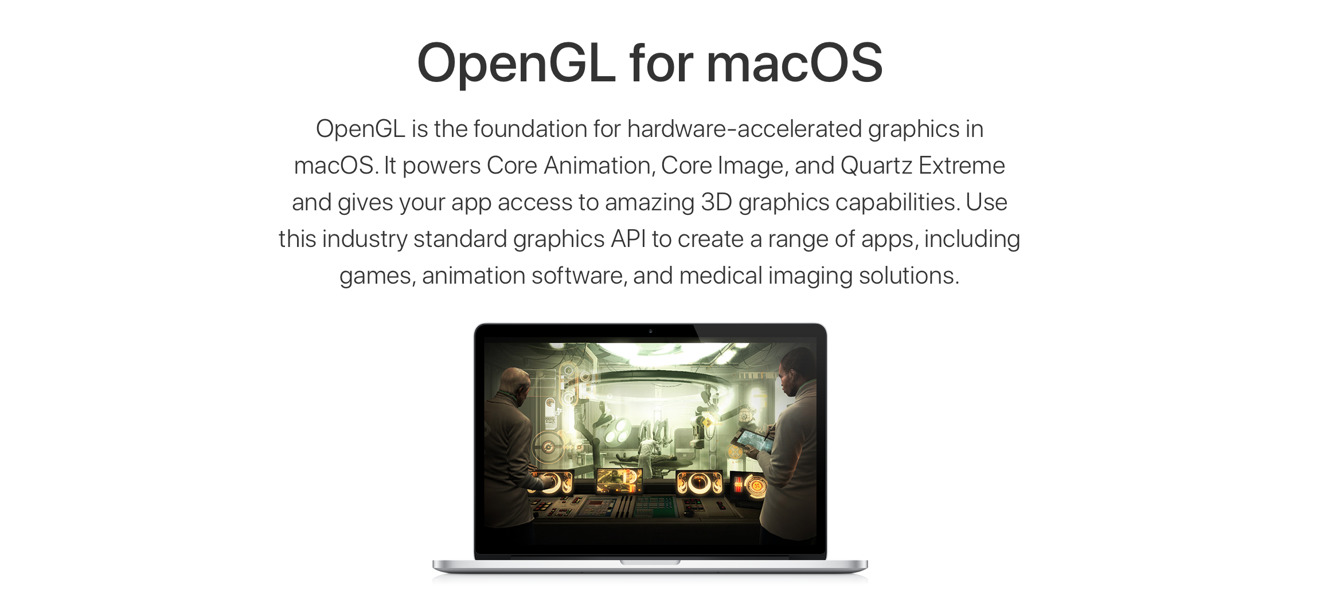
Apple standardized on OpenGL two decades ago
In 2007, Nvidia released CUDA to go far easier to run general-purpose computations on GPUs, known as GPGPU. GPUs are explicitly designed for graphics operations but have characteristics that besides make them ideal for plowing thorough huge sets of non-pixel information. CUDA intended to make GPGPU easier for researchers and developers who weren't already experts in low-level graphics but could do good from existence able to consul their parallel computing tasks to a GPU, where they could run faster than a CPU. Nvidia was, of course, seeking to expand the addressable market for its GPU hardware.
AMD launched its own similarly proprietary "Shut To Metal" project for its GPUs, boot off a GPGPU platform struggle similar to what had occurred earlier in graphics. In 2009, Apple released OpenCL, an open API for GPGPU that wasn't tied to a specific GPU architecture. Apple gave it to the OpenGL standards body to maintain. AMD abased CTM to prefer OpenCL, but Nvidia continued to pursue CUDA. Like Microsoft a decade earlier, Nvidia realized that getting software developers to write and optimize code for its ain proprietary graphics API would cultivate an exclusive market place for its platform, in this instance, Nvidia's GPU hardware.
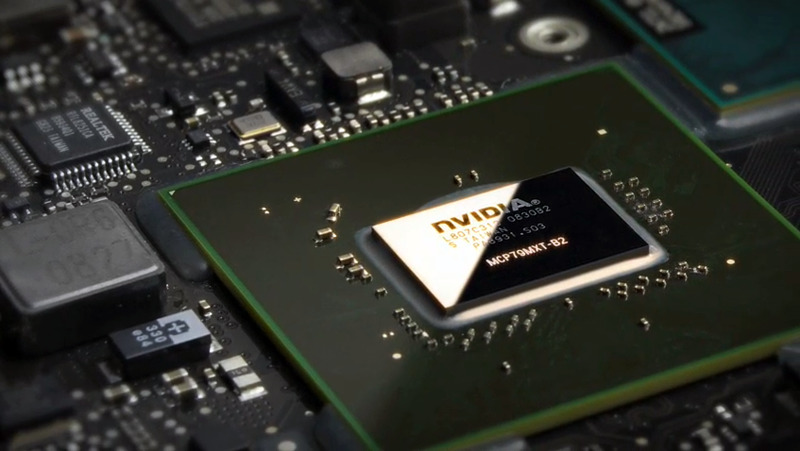
Nvidia GPUs were in one case mutual in Macs a decade ago
That aforementioned year, Apple tree and Nvidia also had a larger falling out related to the lacking Nvidia GPUs in MacBook Pros that resulted in extra support costs and bad optics for Apple tree. There was also an IP dispute between Intel and Nvidia that had forced Apple to change the compages of its 2008 MacBooks.
Nvidia may also have maintained a grudge over having acquired PortalPlayer in 2006 as office of a strategy that was expected to brand Nvidia a chip partner in Apple'southward increasingly successful mobile efforts. That involved Nvidia'southward Tegra mobile chip, which Apple never ultimately used. Tegra chips were later on hyped into the stratosphere by Microsoft Zune and so Surface RT fans and so by Google's Android fans who were enamored with Nvidia's marketing that bragged of Tegra'southward supposedly amazing mobile GPU. The chip never managed to grab up with Apple'southward own mobile SoCs, in function because the vendors who used Tegra couldn't sell their hardware.
The "tranquility hostility" between the in one case-shut partners resulted in no new utilize of Nvidia GPUs in Macs. That included the new architecture of the 2013 Mac Pro, which only offered AMD graphics and had no PCIe slots for stop-users to install their own.
At the time information technology too looked possible that Apple might be losing whatsoever interest in the shrinking market place for "pro" Mac hardware entirely. That same year, Apple had surprised the marketplace with iPhone 5s and the earth's showtime 64-scrap mobile scrap, its custom-designed A7 with a PowerVR GPU, which took the wind out of the sails of Nvidia'due south new, only still 32-bit, Tegra four and effectively destroyed the remains of Nvidia'south mobile armada.
In 2013, AMD besides launched Drapery, its new depression-level graphics API targeted at video gaming, competing with OpenGL and Direct3D and over again setting off a new platform struggle similar to what had occurred earlier in graphics and GPGPUs.
The next year, Apple tree surprised again with the release of Metal, a new graphics API specifically optimized to run "close to the metal" of the GPU in its new A7 and subsequent Apple-designed SoCs. At WWDC14, Apple GPU software engineer Jeremy Sandmel told developers, "we're incredibly excited" and said of Metal, "we believe information technology's literally going to exist a game-changer for you, your applications and for iOS."
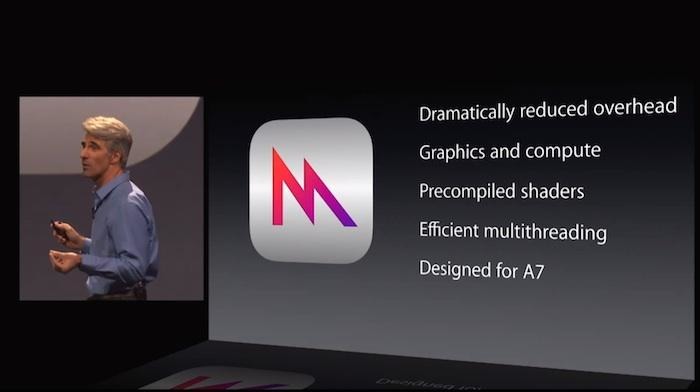
Metal was designed to strip abroad much of the overhead imposed past the cross-platform nature of OpenGL, especially for "land vector," or all of the details associated with each describe call prepared by the CPU and handed to the GPU. This procedure involves a lot of expensive "bureaucracy" under OpenGL. Considering it's optimized to run specifically on Apple tree'southward GPUs, it doesn't have to deal with all of the differences in competing GPU architectures. At the same time, Apple was also freed to add together support for new GPU features without the external dependencies of working inside a standards body.
Apple also introduced its Metallic Shader Language to write "shaders," the specialized computer programs designed to exist quickly run by a GPU. Initially, a "GPU shader" was code that described how to apply the shine shades of colour needed to create realistic surfaces on a 3D model. In today's more general terms, a shader can be whatsoever sort of image or video processing, from calculating the geometries of an blithe 3D model, to rendering individual pixels of a scene, or creating a motion mistiness issue on a frame of video. Shaders can likewise be used to package GPGPU computational tasks for rapid execution on the GPU. This allows Metal to replace both OpenGL and OpenCL, spanning graphics and GPGPU.
OpenGL compiles shader object code on the CPU into GPU machine code earlier information technology can run. This enabled information technology to support a wide variety of different GPUs, each of which needs to have the required shaders compiled specifically for its bit architecture. Considering Metal only runs on the GPUs that Apple uses, it can identify tasks that can be precompiled in accelerate and then that they can execute without delay at runtime. That results in a huge jump in both GPU utilization too as a reduction in CPU overhead, freeing up the system to practise other things.
In 2015 Apple tree released Metallic for macOS, with support for Mac GPUs running back to 2012: Intel Hard disk and Iris GPUs; AMD Graphics Cadre Next GPUs; and the Nvidia Kepler GPUs that Apple had used in its Macs. Last year's macOS Mojave and the current release of Catalina now require a Metal-supported GPU. This more straight positioned Metal as its officially sanctioned way to build video games, leveraging its substantial weight with iOS to influence evolution decisions on the Mac.
Simply ii years afterward burdensome Nvidia'southward Tegra mobile aspirations, Apple was now dropping Metal into its Mac platform where Nvidia notwithstanding had some relevance. That aforementioned year Apple likewise recruited abroad Nvidia's director of deep learning software Jonathan Cohen, who remained at Apple for nigh three years before returning to Nvidia.
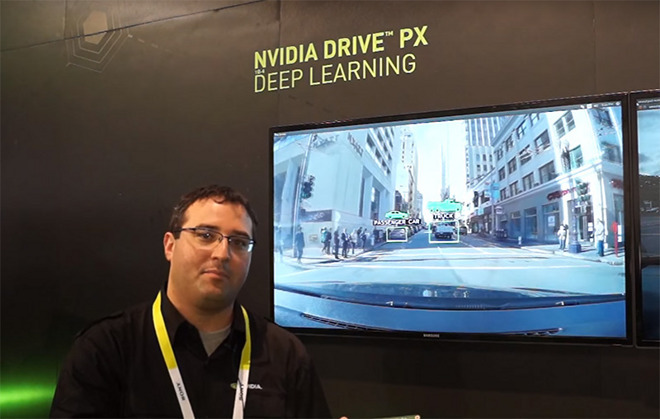
Nvidia's director of CUDA Libraries and Software Solutions auto learning
AMD finer scuttled its internal Mantle development the same twelvemonth, donating it to the OpenGL standards body to maintain as Vulkan starting in 2015. Vulkan offers a modern graphics API similar in arroyo to Apple's Metal and Microsoft's Direct3D 12, giving one-time OpenGL users a path forward on Android, Linux, and Tizen.
In 2017 Apple introduced Metal 2, a farther expansion into Nvidia'due south CUDA territory, with a new shader debugger and GPU dependency viewer for more efficient profiling and debugging in Xcode; back up for accelerating the computationally-intensive task of training neural networks, including car learning; lower CPU workloads via GPU-controlled pipelines, where the GPU is able to construct its rendering commands and schedule them with petty to no CPU interaction; and specialized support for virtual reality rendering and external GPUs.
This year, Apple incrementally avant-garde new Metal ii features in macOS Catalina in anticipation of its new hardware, enabling professional content-creation pro apps to take advantage of Metal Peer Groups to rapidly share information betwixt multiple GPUs in the new Mac Pro without transferring through main retention. Metal Layer API enhancements also provide admission to the High Dynamic Range capabilities of the Mac Pro's new Pro Brandish XDR.
Similar Microsoft since the mid-1990s and Nvidia over the last decade, Apple realized that getting software developers to write and optimize code for its own proprietary graphics API would cultivate an exclusive for its platforms, in this instance, Apple's Mac, iOS, and other hardware.
Looks like Apple wants to ain its graphics engineering
The release of Metal 2 emphasized that Apple was looking to readapt Nvidia's CUDA API, particularly in the areas of automobile learning, bogus intelligence, enquiry, and other GPGPU. Of course, Nvidia has long been working to own GPGPU, particularly in deep learning, the massive processing requirements inherent in self-driving vehicles, and other emerging technologies. By tying these types of applications to its CUDA APIs, Nvidia hopes to keep demand strong for its GPU hardware.
Nvidia's newer Maxwell, Pascal, and Turing-architecture GPUs are not supported under Mojave and Catalina, the two most recent macOS versions that now crave Metal graphics. There isn't a clear answer if the consequence is Nvidia refusing to support Apple tree's Metallic, or Apple refusing to officially approve Nvidia'south drivers. It appears to be both. Apple pretty clearly has a vested interest in expanding manufacture support for its Metal API, the same equally Nvidia with its CUDA platform.
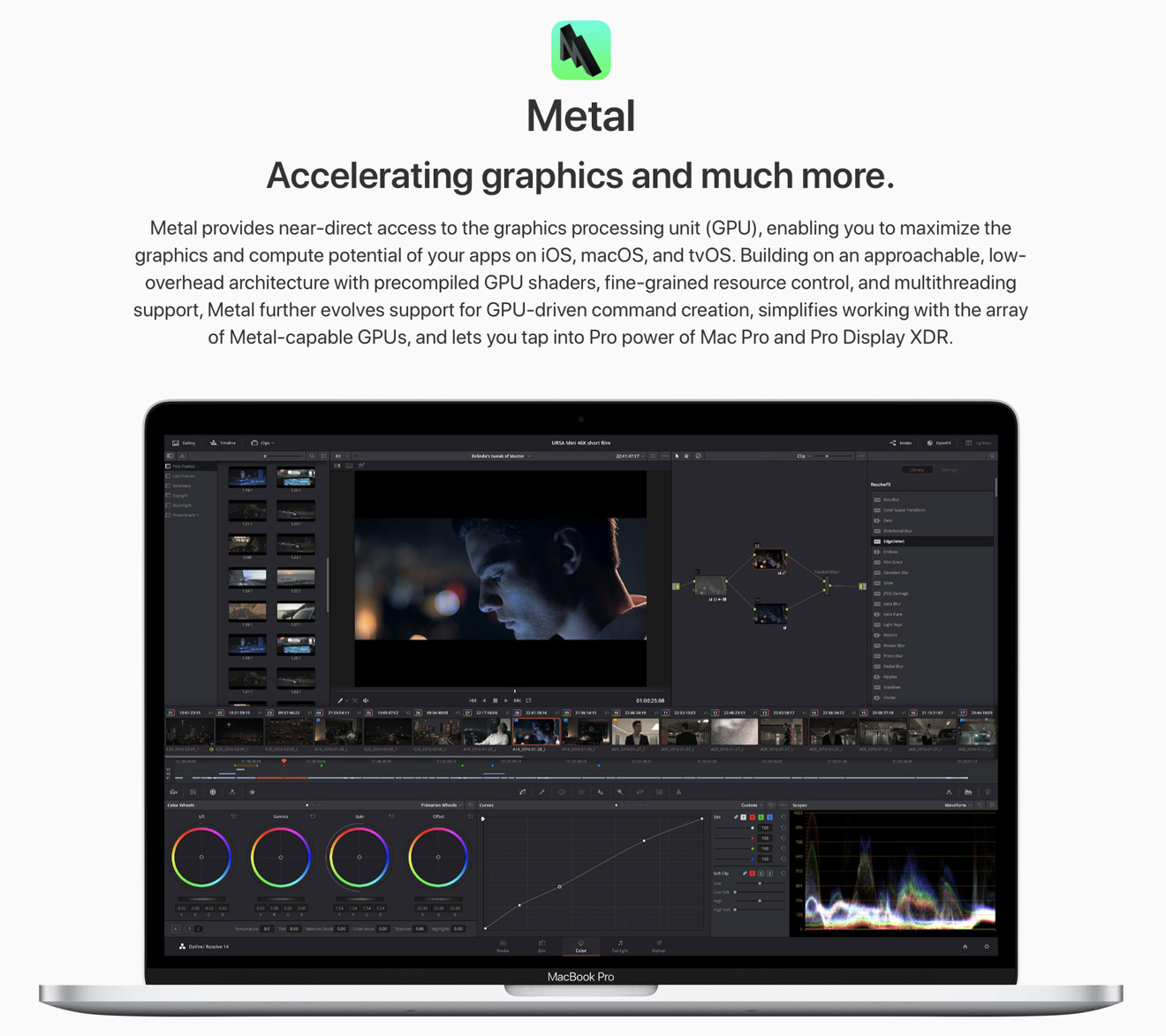
Currently, Apple tree has thoroughly won this skirmish in mobile devices, where Nvidia barely has any remaining relevance after the stinging defeat of Tegra. Apple effectively owns the market for premium mobile phones, tablets, and wearables, despite vibrant and unrestricted competitive efforts from Samsung, Huawei, Google, and others. That's nearly immaterial because Nvidia's CUDA doesn't have any relevance on mobile devices anyway.
In consumer markets, Apple tree has also established Metal in partnerships with video game developers including Aspyr, Blizzard Amusement'due south WoW and SC2 engines; Feral Interactive; Unity; and Epic Games' Unreal Engine. A diverseness of other graphics-oriented Mac software developers have also embraced Metal, including Adobe, Autodesk, Pixelmator, and Affinity Photograph's Serif.
Moving to Metal is attractive for developers because it delivers higher performance than OpenGL, and provides access to Apple'southward huge installed base of operations of affluent iOS users and its meaning base of 100 million higher value Mac users. At WWDC17, Apple cited 148,000 applications that brand use of Metallic direct and another 1.vii 1000000 that benefit from higher-level frameworks that accept been optimized for Metal. There are more users on Android, but those users don't pay for software the way Apple'southward platform buyers do.
Apple has depreciated, merely non yet removed, macOS support for OpenGL. But there is increasingly little reason to keep maintaining information technology considering even OpenGL's standards body is seeking to motion to a new, more modern and optimized replacement in the form of Vulkan. Vulkan code can even exist hosted on meridian of Metal using MoltenVK. The other major alternatives are DirectX, used by Microsoft in Windows and Xbox, and CUDA, which is limited to Nvidia hardware.
Where uptake of Apple tree's Metal had been weakest— and Nvidia CUDA strongest— is in higher-finish markets for research, artificial intelligence, car learning, deep learning, and other professional person work. Nvidia has invested in efforts to create scientific modeling, medical imaging, and other specialized software and workflows dependent upon CUDA, and therefore its GPU hardware, for a decade now.
Apple tree hasn't fifty-fifty introduced a new Mac Pro since information technology outset debuted Metallic, making the new Mac Pro its starting time-ever built exclusively for Metal, and the first Metallic Mac with PCIe slots autonomously from the 2010 Mac Pro models that were supported in Mojave if upgraded with a Metal GPU card. Those aging machines are no longer supported Catalina.
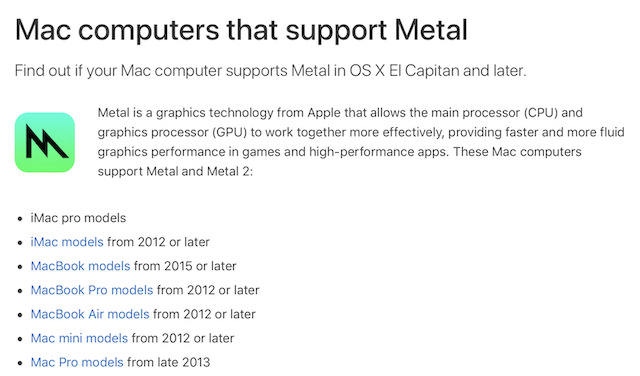
Metal Macs
Across the terminal several years, Apple tree has been working with a variety of pro app developers, as well as AMD, to develop pro-tier Metallic support. Apple'due south prominent focus on the graphics capabilities of Mac Pro, including the mention of AMD's Radeon Pro Vega Two Duo as "the globe's most powerful graphics card," pairing two GPUs together on one bill of fare connected by Infinity Material Link, wasn't just boasting. It was signaling potential applications of the new machine.
When Apple detailed that two of those MPX mega boards could be installed in tandem, providing "56 teraflops of graphics performance" and a combined 128GB of super-fast, dedicated GPU RAM, it was a nebulous merits to make nearly graphics only a powerful statement about how much raw processing power a Mac Pro could provide in the area of GPGPU chapters.
Apple has also been making a potent case for machine learning on the Mac. Its new Create ML lets developers create and train models— such every bit object detectors, paradigm, and audio classifiers, give-and-take embeddings and transfer learning for text classification, and recommendation engines— using libraries of sample information right on their automobile, without needing to rely on a model grooming server. ML preparation is 1 example of a not-graphical use of GPU hardware, to crisis through computationally circuitous ML training sessions. Information technology also has direct relevance to Mac app developers, building on Apple tree'southward massive installed base of users and the ecosystem of coders it sustains.
Along with ML, Apple tree has various other aspirations in what is now Nvidia'southward CUDA territory. In the firsthand term, it has largely focused on the more than easily attainable goal of getting more high-finish, creative professional software to cover Metal. Information technology started these efforts well before information technology publicly unveiled the new Mac Pro. In June, it offered a list of effulgent messages of support from Adobe, Avid, and others, indicating significant outreach by Apple to bring more than software to the Mac, leveraging the efficiency of Metal and the processing capacity of the new Mac Pro.
Sebastien Deguy, Adobe'south vice president of 3D and Immersive, stated that "we're incredibly excited nigh the new Mac Pro, which represents a strong commitment from Apple tree towards creatives working in 3D. We've already started porting the Substance line of tools, as well as Dimension, to Apple'south new graphic API Metal to fully have reward of the immense power the new Mac Pro hardware offers and empower 3D creatives in unprecedented ways."
Jules Urbach, the CEO and founder of OTOY, stated he was "incredibly excited most the all-new Mac Pro and how it will empower our users.," adding that his company'southward Octane Ten "has been rewritten from the footing upwardly in Metal for Mac Pro, and is the culmination of a long and deep collaboration with Apple's world-course engineering team.
"Mac Pro is like nothing we've seen before in a desktop system. Octane X will be leveraging this unprecedented performance to take interactive and production GPU rendering for film, Goggle box, motion graphics and AR/VR to a whole new level. Octane X is truly a labor of love, and we tin't wait to get it into the easily of our Mac customers later this year."
Note that Mac Pro not only took Apple tree years of applied science but also involved a "long and deep collaboration" with pro software developers like OTOY, with Metallic at the center of that piece of work. Metal is pretty clearly a big priority for Apple.
Blackmagic Pattern CEO Grant Petty similarly chosen his company's DaVinci Resolve not only "the globe'south nigh advanced color correction and online editing software for high-end film and television work" just also "the offset professional software to prefer Metal."
He added that "with the new Mac Pro and Afterburning, we're seeing full-quality 8K performance in real-time with colour correction and effects, something nosotros could never dream of doing earlier. DaVinci Resolve running on the new Mac Pro is hands the fastest way to edit, grade and end movies and Goggle box shows."
Maxon CEO David McGavran similarly stated that his company is "excited to develop Redshift for Metal," adding that "we're working with Apple to bring an optimized version to the Mac Pro for the first time by the finish of the yr. We're likewise actively developing Metal back up for Cinema 4D, which will provide our Mac users with accelerated workflows for the most complex content cosmos. The new Mac Pro graphics architecture is incredibly powerful and is the all-time system to run Movie house 4D." That's a lot of Metal work.
Francois Quereuil, Avid'due south director of Product Direction, stated that "Avid'south Pro Tools team is blown away by the unprecedented processing power of the new Mac Pro, and thank you to its internal expansion capabilities, upwardly to vi Pro Tools HDX cards can be installed within the system - a beginning for Avid'southward flagship audio workstation. We're now able to deliver never-before-seen functioning and capabilities for audio product in a unmarried system and deliver a platform that professional users in music and postal service have been eagerly pending."

At WWDC19, Mac Pro was shown running Avid Pro Tools with six HDX cards installed
Pixar'south vice president of Software Research and Development, Guido Quaroni, stated, "we are thrilled to announce total Metal support in Hydra in an upcoming release of USD toward the terminate of the year. Together with this new release, the new Mac Pro will dramatically advance the well-nigh demanding 3D graphics workflows thanks to an excellent combination of memory, bandwidth, and computational operation. This new automobile clearly shows Apple tree is delivering on the needs of professionals at high-end production facilities like Pixar."
Amy Bunszel, the senior vice president, Autodesk Pattern and Creation Products, stated "Autodesk is fully embracing the all-new Mac Pro and we are already working on optimized updates to AutoCAD, Maya, Fusion, and Flame. This level of innovation, combined with adjacent-generation graphics APIs, such as Metal, bring extremely high graphics functioning and visual fidelity to our Blueprint, Manufacturing and Creation products and enable us to bring greater value to our customers."
Jarred Land, the president of Reddish Digital Movie theater, said "Apple'south new hardware will bring a mind-blowing level of functioning to Metallic-accelerated, proxy-costless R3D workflows in Last Cut Pro X that editors truly have never seen earlier. We are very excited to bring a Metal-optimized version of R3D in September."
Foundry'due south chief product and customer officeholder Jody Madden said, "with the all-new Mac Pro, Apple delivers incredible operation for media and entertainment professionals, and we tin can't wait to see what our customers create with the immense power and flexibility that Mac Pro brings to artists. HDR is quickly becoming the standard for capturing and delivering loftier-quality content, and the Pro Display XDR volition enable Nuke and Nuke Studio artists to piece of work closer to the final image on their desktop, improving their speed and giving them the freedom to focus on the quality of their work. We await frontwards to updating our products to have reward of what Mac Pro offers."
Bill Putnam Jr., the CEO of Universal Audio, stated, "the new Mac Pro is a breakthrough in recording and mixing performance. Thunderbolt 3 and the numerous PCIe slots for installing UAD plug-in co-processors pair perfectly with our Apollo X serial of audio interfaces. Combined with the sheer processing power of the Mac Pro, our most demanding users will be able to rails and mix the largest sessions effortlessly."
Matt Workman, the developer of Cinematics Tracer, said "cheers to the unbelievable power of the new Mac Pro, users of Cine Tracer will exist able to piece of work in 4K and college resolution in real-time when visualizing their projects. And with twice as many lights to work within the aforementioned scene, combined with Unreal Engine's real-time graphics applied science, artists can now load scenes that were previously too big or graphically taxing."
Kim Libreri, the CTO Epic Games, said, "Epic'due south Unreal Engine on the new Mac Pro takes advantage of its incredible graphics performance to evangelize astonishing visual quality, and will enable workflows that were never possible before on a Mac. Nosotros tin't wait to encounter how the new Mac Pro enhances our customers' limitless creativity in cinematic production, visualization, games and more."
Unity'southward vice president of Platforms, Ralph Hauwert, stated, "we're so excited for Unity creators to tap into the incredible power of the all-new Mac Pro. Our powerful and accessible real-time technology, combined with Mac Pro's massive CPU ability and Metal-enabled high-end graphics performance, along with the gorgeous new Pro Display XDR, will give creators everything they need to create the next smash-hit game, augmented reality experience or award-winning animated feature."
Simonas Bastys, the lead developer at Pixelmator, stated, "he new Mac Pro is insanely fast — it's by far the fastest epitome editor we've ever experienced or seen. With the incredible Pro Brandish XDR, all-new photo editing workflows are at present a reality. When editing RAW shots, users tin can cull to view extended dynamic detail in images, invisible on other displays, for a phenomenal viewing experience like nosotros never imagined."
Cristin Barghiel the vice president of Product Development at SideFX, stated, "with the new Mac Pro's incredible compute performance and astonishing graphics architecture, Houdini users will be able to work faster and more efficiently, unleashing a whole new level of creativity."
Serif's managing manager Ashley Hewson said, "Affinity Photo users demand the highest levels of functioning, and the new, insanely powerful Mac Pro, coupled with the new detached, multi-GPU support in Photo one.seven allows our users to work in existent-time on massive, deep-color projects. Thank you to our extensive Metallic adoption, every stage of the editing process is accelerated. And as Photo scales linearly with multiple GPUs, users will meet upward to iv-fourth dimension performance gains over the iMac Pro and 20 times over typical PC hardware. It's the fastest system nosotros've ever run on. Our Metal back up besides means incredible HDR back up for the new Pro Display XDR."
Simply having a super-powerful Mac Pro model with vast expansion capability won't necessarily sell millions of the new machines. The market for high-end workstations remains relatively small. But it will let Apple to find fresh interest in new industries and help bring more software — particularly high end, specialized, creative pro piece of work titles — to the Mac, optimized for Metal. That will do good users of any Mac. Additional programmer interest and feel in coding for Metal will besides do good iOS, Apple TV and even Apple Watch development.
It remains to be seen if Apple will go on actively investing in its Mac Pro and deliver regular upgrades that keep it up to date. However, the Apple tree of today is far amend positioned to do this than the Apple of 2010, back when it was struggling with Xserve and badly trying to go on Google's new Android consortium from destroying the iPhone. As I've noted since at least 2016, Apple finer lacks whatever real consumer competition. Information technology's at present graduating into the high end of calculating to take on new bosses.
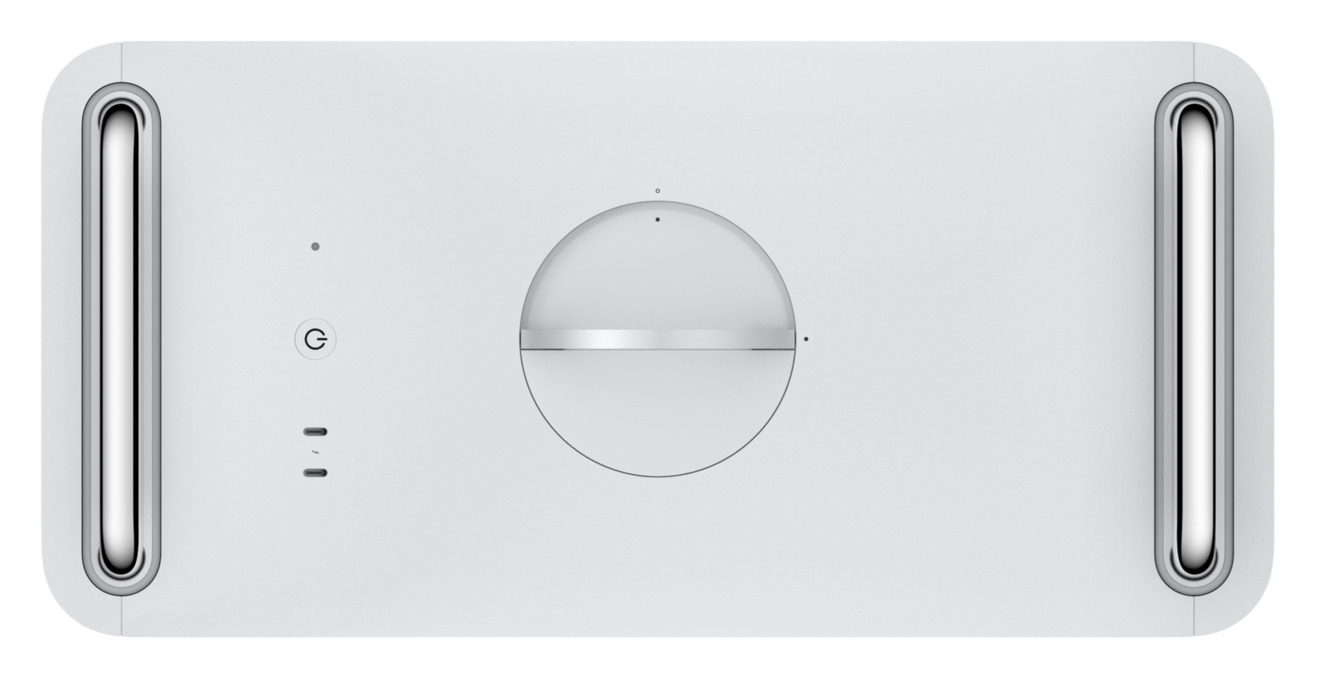
Apple'south new Mac Pro caters to a different tier of buyers
Rather than expanding into the territory of larger and more than entrenched rivals, as Apple was forced to do with Macs, iPod, iPhone, and iPad over the past 2 decades, the visitor is at present setting its sights on smaller rivals with less capital and influence: Spotify, Netflix, and Nvidia. It has to, because Apple is now vastly larger and more influential than ever, and its rivals are all at present relatively smaller, and weaker.
Ane tin be righteously indignant that Apple tree isn't subsidizing anybody else with back up for their platforms, whether CUDA, Vulkan, or even Android. Just such emotions won't have any begetting on the concluding issue of who wins and who loses in the market for developing and commercializing the graphics technology of the future. Apple supporters in the 1990s didn't accept any impact on how things turned out, no affair how well-reasoned their ideological arguments were as they typed them into the Internet.
What remains to exist seen is how well Apple tree as a company implements its strategies, and how effectively it delivers hardware and software products that solve the needs of its customers. Large companies in the atomic number 82 have fallen behind before by growing complacent.
Since 2012, Apple has proven it tin incrementally iterate in software on an annual cycle with both iOS and macOS, and deploy new software rapidly across a unified installed base of operations of users. And this year, Apple has dramatically expanded into Services, with both Apple Arcade and Apple TV+ acting as content factories that tin can directly benefit from this parallel push into professional product tools, generating the creative work that induces the new and advancing software that enriches its ecosystem.
Apple appears to exist inbound the 2020s as if it was an Atari, a Disney, a Pixar, a Microsoft, an Intel, a HP, a Canon, a Sony, and a Nokia all rolled into one. It should be an interesting decade ahead.
0 Response to "Is Metal 2 a Software or Hardware"
Post a Comment